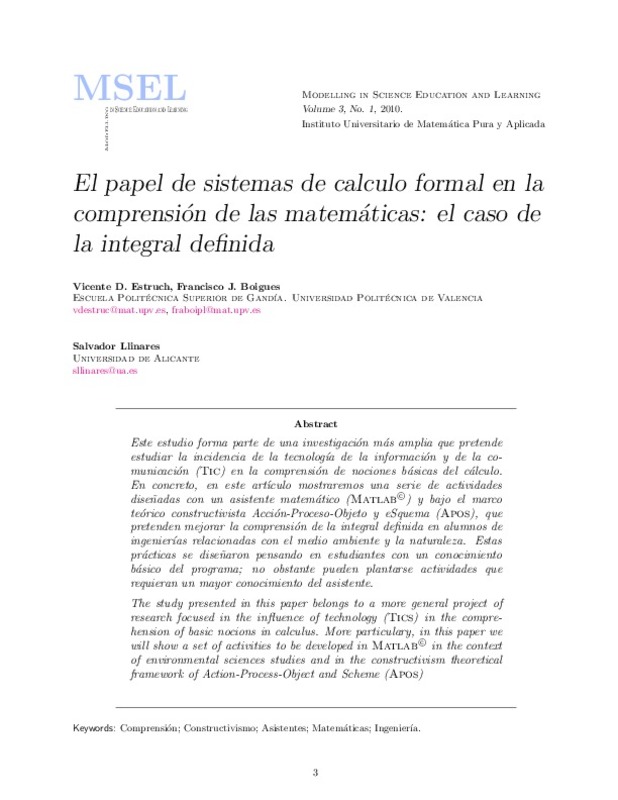Anton H. (1984). Cálculo y geometría analítica. Ed. Limusa, México.
Artigue, M., Douady, R., Moreno, L., Gómez, P. (1995). La ense-anza de los principios del cálculo: problemas epistemológicos, cognitivos y didácticos. Ingeniería didáctica en educación matemática. Grupo Ed. Iberoamericana, 97-140.
Artigue, M., Batanero C., Kent, P. (2007). Mathematics thinking and learning at post secondary level. In Fr. Lester (ed.), Second Handbook of research on Mathematiccs teaching and learning. NCTM-IAP; Charlotte, NC, 1011-1045.
[+]
Anton H. (1984). Cálculo y geometría analítica. Ed. Limusa, México.
Artigue, M., Douady, R., Moreno, L., Gómez, P. (1995). La ense-anza de los principios del cálculo: problemas epistemológicos, cognitivos y didácticos. Ingeniería didáctica en educación matemática. Grupo Ed. Iberoamericana, 97-140.
Artigue, M., Batanero C., Kent, P. (2007). Mathematics thinking and learning at post secondary level. In Fr. Lester (ed.), Second Handbook of research on Mathematiccs teaching and learning. NCTM-IAP; Charlotte, NC, 1011-1045.
Asiala, M., Brown, A., DeVries, D., Dubinsky, E., Mathews, D., & Thomas, K. (1996). A framework for research and curriculum development in undergraduate mathematics education. CBMS Issues in Mathematics Education, 1-32. doi:10.1090/cbmath/006/01
Baker, B., Cooley, L., Trigueros, (2003). Thematization of the Calculus Graphing. Proceedings of the XXVII annual of the PME, vol. 2, 57-64.
Boyer, C.(1949). The History of the Calculus and its conceptual development. Dover, New York.
Cobb, P., Confrey, J., diSessa, A., Lehrer, R., & Schauble, L. (2003). Design Experiments in Educational Research. Educational Researcher, 32(1), 9-13. doi:10.3102/0013189x032001009
Czarnocha, B., Loch, S., Prabhu, V., Vidakovic, D. (2001). The concept of definite integral: coordination of two schemas. Proceedings of the XXV annual of the PME, vol. 2, 297-304.
Dubinsky, E. (1991). Reflective abstraccion in advanced mathematical thinking. In D. Tall (Ed.), Advanced Mathematical Thinking, Dordrecht: Kluwer Academic Press, 95-123.
Dunham, W. (2005). The Calculus Gallery. doi:10.1515/9781400866793
Ferrara, F. Pratt, D. Y Robutti, O. (2006). The Role and uses of technologies for the teaching of Algebra and Calculus. In A. Gutierrez and Boero (Ed.), Handbooks of Research on the Psychology of Mathematics Education. Past, Present and Future. Sense Publishers, 237-274.
Kent P. y Noss R. (2003). Mathematics in the University education of engineers (A report to the Ove Arup Foundation). London: The Ove Arup Foundation.
Kline, M.(1972). Mathematical thought from ancient to modern Times. Oxford University Press. Holton, D. (2001). The teaching and learning of mathematics at university level. An ICMI Study. Dordrecht, The Nertherlands: Kluwer.
Larson R.E., Hostetler, R.P., (1989). Cálculo y geometría analítica. Tercera edición, McGraw-Hill, Madrid.
McDonald, M. A., Mathews, D., Strobel, K. (2000). Understanding sequences: A tale of two objects. In E. Dubinsky, J. J. Kaput y A. H. Scoienfeld (Eds.), Research in Collegiate Mathematics Education Vol.IV. CBMS Isuues in Mathematics education 8, 77-102.
Meel D. E. (2003). Modelos y teorías de la comprensión matemática: comparación de los modelos de Pirie y Kiriem sobe evolución de la comprensión matemática y la teoría APOE. Revista Latioamericana de Investigación en Matemática Educativa, 6(3), 221-272.
Orton, A. (1983). Students’ understanding of integration. Educational Studies in Mathematics, 14(1), 1-18. doi:10.1007/bf00704699
Piaget, J. (1985). The equilibrium of cognitive structures. Cambridge, M.A. Harvard University Press.
Rasslan, S. & Tall, D.(2002). Definitions and imagens for the Definite Integral Concept. Proceedings of the XXVI annual of the PME, vol. 4, 89-96.
Steffe, L. & Thompson, P. (2000). Teaching Experiment methodology: Underlying Principles and essen- tial Elements. En A. Kelly, & R. Lesh (eds) Handbook of Research Design in Mathematics and Science Education, Mahwah, NJ: Lawrence Erlbaum Associates Pubs, 267-306.
Tall, D. (2000). Cognitive development in advanced mathematics using technology. Mathematics Education Research Journal, 12(3), 196-218. doi:10.1007/bf03217085
Thomas-Finney (1987). Cálculo y geometría analítica. Vol.1. Sexta edición, Addison-Wesley Iberoamérica. [27] Trigueros, M., (2005). La noción de esquema en Matemática educativa a nivel superior. Educación Matemática, 17 (1), 5-31.
Tall, D., & Vinner, S. (1981). Concept image and concept definition in mathematics with particular reference to limits and continuity. Educational Studies in Mathematics, 12(2), 151-169. doi:10.1007/bf00305619
[-]









